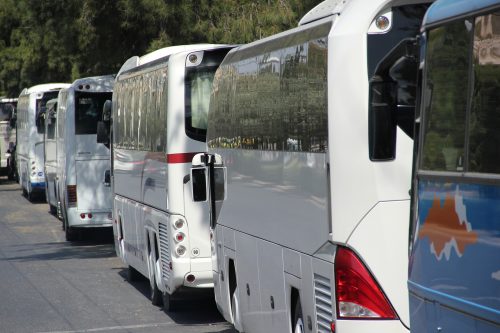A new technological venture promises to bring the good news of smart public transportation to Israel, to optimize the operation of the lines and reduce waiting times

By Alina Arbitman, Angle, Science and Environment News Agency
The buzz word "big data" has been encountered quite a lot in recent years. It refers to the huge amounts of raw data that pass through the internet, cellular networks and practically every computer network, and are stored on company and government servers. This is Bloom's treasure trove for finding patterns and patterns, and in recent years it has led to significant developments in the fields of medicine, finance, science and, in fact, in almost every field of our lives.
"Big data" is usually said in the same breath with words like high-tech, startup and exit. Now, thanks to researchers from Tel Aviv University and Ben Gurion University, this technology is reaching a field that in Israel, and to a large extent rightly, suffers from a very outdated image: public transportation.
Stuck in the 20th century
Long travel times, low frequency, overcrowding, winding routes, standing in traffic jams alongside private cars - all these are the daily lot of public transport users in Israel. This situation costs the taxpayer a lot of money, not only because of the precious working hours that are wasted in traffic jams, but also because Pollution The air The high that is produced by the traffic loads throughout the country and causes more than a thousand deaths every year.
There are many and varied reasons for this situation, one of which is less well known: public transportation planning in Israel is based on data that is no less than a decade old.
In 2007, the Central Bureau of Statistics conducted a survey that examined the connections between the residential areas of Israeli residents and the employment areas. The survey divided the Tel Aviv metropolis into more than 1200 traffic zones and examined, for every two traffic zones on the map, how many people travel from one zone to another on a daily basis - for example, from the streets near Jerusalem Avenue in Jaffa to the Tel Aviv University area.
Surprisingly, from then until today this is the main professional work tool used by the National Authority for Public Transportation when examining new routes for bus lines. Another tool is surveys that are conducted inside the buses in which the passengers are asked about their points of origin and destination (and therefore they do not include the passengers of the private vehicle). "In an age where most passengers have a smartphone with a GPS component and apps like Waze that predict traffic congestion, the public transportation network in Israel is based on data that is ten years old," says Gil Yaakov, CEO of 15 Minutes, an organization of public transportation consumers in Israel. "The Israeli government remained in the 21th century, while the professional tools advanced to the XNUMXst century," he adds.
Prof. Yitzhak Benanson from the Department of Geography and the Human Environment at Tel Aviv University and Dr. Eran Ben Elia from the Department of Geography and Environmental Development at Ben Gurion University of the Negev decided to change this situation. Together with Golan Ben Dor from Tel Aviv University and Dr. Bela Dmitriev from Ben Gurion University, they started the ambitious project two years ago ״transportation Public wisdom״ which is financed by the Ministry of Transport and held at the same time in several universities and research institutes in Germany, Belgium, Sweden and Poland, as part of the EraNet academic cooperation network of the European Union. The purpose of the Israeli project, which was recently presented At the conference ״Cities smart״At Tel Aviv University, it is to build a software system that can help the professionals at the Ministry of Transportation to plan better public transportation in the Tel Aviv metropolis - one that is adapted to the needs of today's travelers, and no less importantly - to enable the introduction of changes and improvements over time, in accordance with the changing patterns of use and demand.

"Currently, public transportation in Israel in general and the Dan bloc in particular is not adapted to the needs of the users," explains Prof. Benanson. "The goal of our research team is to assess the mismatch between the demand - the needs of passengers, and the supply - the existing public transportation network, and match them. Also, the system we are building will make it possible to make changes in the future, so that public transportation will remain adapted to the changing needs.'
This time, in order to answer the question of how many people travel daily from area A to area B in the Tel Aviv metropolis, the researchers are using statistical information collected by the Ministry of Transportation on the use of the Rabbi Ko cards, and in the future, they hope, also statistical and anonymous data from the cellular companies on location-based information which is received from mobile phones. In addition, they have at their disposal databases such as routes and schedules of the existing public transportation network, as well as maps with information layers of transportation routes, population concentrations, etc. All this information is fed into the algorithms that are used to plan a public transportation system that efficiently serves the passengers and allows them to quickly reach their destination.
release the congestion
Another tool used by researchers is system Code open To simulate the behavior of users of the transportation network, to predict the reaction of passengers to the changes proposed by the algorithms. The system has proven itself in many countries in the world to be highly predictive of passenger behavior, among others in Germany, Austria, Switzerland, Singapore, Sweden, Belgium and Poland, and is used there by the professional bodies for transportation planning.
For example, a certain change in public transportation can be introduced into the system: from adding a line on a new route or changing the route of an existing line, through changing the frequency or schedule to moving stations, changing the capacity of the vehicles (from a bus to a minibus or vice versa) or the means of transportation (bus/service taxi) ) and adding a route (public transportation route), and the system will predict the users' reaction to the change. "If I see in the simulation that there is an unlikely congestion in a certain section, I can add a line in that section to release the congestion," explains Benanson.
Adapting the imaging system to Israel presented the researchers with an unexpected challenge, in light of the fact that all major cities in the world have public transportation routes, while Israel has very few such routes. "This significantly affects the speed of the buses in the simulation, and required us to introduce special adjustments in the system," explains Benanson. Gil Yaacov from the Public Transportation Consumers Organization emphasizes the importance of public transportation, because "public transportation routes are the basis of every public transportation system in the world. In order for it to be reliable, predictable and competitive with respect to travel times by private vehicle, a network of public transport networks is required in the cities and on the intercity roads leading to them. Unfortunately, the Ministry of Transportation is delaying the establishment of interchanges on the intercity routes, and as for the urban routes, it depends on the approval of the mayors. I really hope that their development will accelerate in the coming years.".
The researchers hope that the transportation planners will use the system once every few months, and according to its recommendations, changes will be made on a small to medium scale. "On such a scale, as opposed to reforming lines as was the case in Gush Dan several years ago, we can predict the public's reaction with a fairly high degree of accuracy using our simulation system," explains Benanson. "In the long term, we want to fundamentally change the system: from a rigid and fixed system that passengers have to adapt to, to a modern and flexible system that uses information and communication technologies that are at the forefront of science to optimally adapt to passengers," he adds.
However, it is important to understand that any change in public transportation requires preparation both on the planning side (on which the system responds) and on the execution side, which involves the approval of the Ministry of Transportation. In the case of a change that requires a budget increase, such as adding a new line or increasing frequency, approval from the Ministry of Finance will also sometimes be required, and if the change involves placing a new station - then also coordination with the local authority. "There is no doubt that the system needs to adapt itself to a different rate of operation even in the current situation and certainly in the future with advanced technologies," says Yaakov.
Visualization of the vehicles in Tel Aviv: the private vehicles are represented by green triangles and the buses by blue circles
Israeli travelers are smart
Today, the system for planning smart public transportation is under development, and the researchers are waiting to receive statistical information from the cellular companies. Until the system is put into use by the National Public Transportation Authority, one remains to wonder: beyond the expected improvement in the quality of life of the existing public transportation users (who waste about 120 hours a year waiting for buses), how many passengers will leave their private car in the parking lot and switch to the bus following the implementation of the advanced system? Yaakov Optimi: "The public learns to adapt quickly and prefers fast public transportation - when it exists - over the comfort of a private car. And as you can see, thousands of drivers leave their cars in the Hana parking lot and drive through the Shapiri interchange and ride the shuttles that go directly to the employment centers on a fast and dedicated route. Apps like Mobit, Uber, GetTaxi as well as ride-sharing apps prove that Israeli travelers are smart.' He concludes: "I hope that the State of Israel, which is proud of its technological initiatives, will know how to adopt the latest technology also in the field of planning public transportation and mass transportation."
See more on the subject on the science website:
